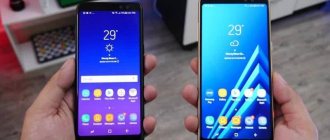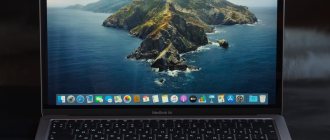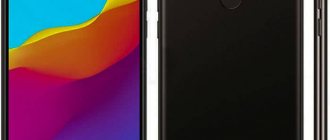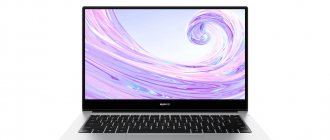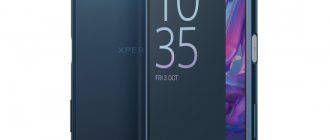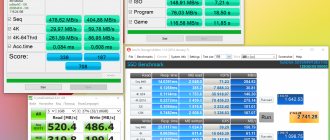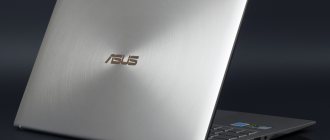The updated Huawei MateBook X Pro 2020 is a powerful and premium ultrabook with a tenth generation Intel Core processor. The device impresses with its high-quality materials, modern design and display with very thin frames.
However, does the compact appearance affect everyday use? You will find the answer to this and other questions in my review.
Specifications Huawei MateBook X Pro 2020
| Display | Touch, glossy, 13.9-inch with a resolution of 3000x2000 pixels |
| CPU | Intel Core i7-10510U |
| Video card | NVIDIA GeForce MX250 + Intel UHD |
| RAM | 16 GB LPDDR3 RAM 2133 MHz |
| Inner memory | 1 TB SSD NVMe M.2 PCIe |
| operating system | Windows 10 Pro |
| Audio and sound | Four speakers with Dolby Atmos technology |
| Webcam | 1-MP |
| Wireless connection | NFC, WiFi 802.11 a/b/g/n/ac 2.4 and 5 GHz, Bluetooth 5.0 |
| Connectors and ports | Full size USB 3.1 Gen. 1, USB-C + USB-C with Thunderbolt support, 3.5 mm audio jack |
| Battery | 56 W/h |
| Biometrics | Fingerprint's scanner |
| Size and weight | 304×217×14.6 mm, 1.33 kg |
| Price | From 130,000 rub. ($1765) |
Performance
The new MateBook X Pro is built on an Intel Core i7‑10510U processor, made using an improved 14‑nm process technology. The laptop is capable of entering turbo mode, supplying up to 50 W of power to the processor. The frequency at such moments reaches 4.9 GHz per core, but you won’t be able to work with it for more than 16 seconds: the cooling system cannot cope with the heat dissipation. The device quickly puts the processor on a leash, transferring it to a base power of 18 W.
The MateBook X Pro can be compared to a sprinter that is exceptionally fast over short distances. Such accelerations are enough to handle most tasks with lightning speed: from compiling code and launching programs to processing files. The laptop scores about 1,400 points in the Cinebench R20 benchmark; system performance during the test was recorded by the Intel Power Gadget utility.
The RAM capacity is 16 GB, which is enough for comfortable multitasking. The 1,024 GB SSD offers fast read and write speeds.
Screenshot: CrystalDiskMark 7
The NVIDIA GeForce MX250 discrete video accelerator is responsible for the graphics, but you shouldn’t expect impressive performance in games due to the limited thermal package (TDP) of 10 W. This means that the video card is not capable of developing a high frequency. However, its capabilities are enough for easy work in programs that support GPU acceleration, for example in the Adobe package or Blender 3D.
The laptop also supports external graphics cards with a Thunderbolt 3 connection, but the performance gains vary from program to program. In addition, Intel Comet Lake processors are not equipped with an integrated Thunderbolt controller - this is the prerogative of the Ice Lake generation. So the stability of working with external GPUs is a big question.
Design and appearance
At first glance, it is difficult to notice any changes in the design of the MateBook X Pro 2020. However, the difference in the color of one of the options is enough to make everything clear. The new model is available, in particular, in a green body color, which definitely stands out among competitors' offerings.
In the photos, the Emerald Green version looks bright green. In reality, it is dark green and looks different in person than in the photos you find on the Internet.
Another worrying fact is that the laptop's flap collects fingerprints, which are very difficult to remove. Terribly annoying, from an aesthetic point of view. In terms of design and ports, the Huawei MateBook X Pro 2020 is no different from the 2019 version. It also has a 3.5mm jack, two USB Type-C ports, one full-size USB, and a recess for easy opening of the lid.
At the bottom we have four non-slip feet that ensure the laptop adheres well to flat surfaces.
⇡#Appearance and input devices
The MateBook X Pro is made entirely of metal. I liked the Space Gray color. The manufacturer claims that the surface of the case is sandblasted, so it is matte and does not attract dust and fingerprints.
The MateBook X Pro is very compact, although the ultrabook uses a 13.9-inch matrix - the width of the laptop is 304 mm. For example, the recently tested HP Specter 13 turned out to be 11 mm wider, but this laptop has a matrix with a smaller diagonal. It's just that the MateBook X Pro has very thin bezels (4.4 mm) - thin on all four sides of the screen. As a result, the 13.9-inch display occupies 91% of the surface of the top cover.
Yes, the MateBook X Pro does not break records in terms of thickness (14.6 mm) and weight (1.33 kg). At the same time, traveling with the ultrabook turned out to be very comfortable. In addition, the external power adapter along with the USB cable weighs only 200 grams.
The laptop lid opens up to about 135 degrees - the design uses very tight hinges, they clearly position the screen and prevent it from dangling even while typing, for example, on the subway. At the same time, in the lower part of the case, on the front panel, there is a special recess, with which it is very easy to open the display cover with just one hand.
The MateBook X Pro does not have any elements on the front or back. It may seem that the laptop uses a passive cooling system, since the air inlet/outlet grilles are not visible. But they are there and hidden under the display cover.
The MateBook X Pro can easily be called a functional ultrabook. HUAWEI engineers managed to bring a standard USB 3.1 Gen1 A-type port to the right side. On the left side there is a Thunderbolt 3 connector combined with USB 3.1 Gen2 Type-C, USB 3.1 Gen2 Type-C and a 3.5 mm jack for connecting headphones. Perhaps the only thing missing from the MateBook X Pro to be completely happy is a card reader.
The laptop power key is multifunctional. It has an integrated fingerprint sensor that allows you to unlock the desktop. The laptop wakes up instantly from sleep mode.
Overall, the MateBook X Pro has a very comfortable keyboard. Unfortunately, due to the size of the case, the laptop does not have full-size Home, Page Up, Page Down and End keys, but under the main buttons there is a really huge touchpad.
The strengths of the MateBook X Pro keyboard include the large size of the keys and the distance between them. The comfort when typing is as if you were working on a 15.6-inch laptop - only without a digital pad. Matebook has a full-size Backspace; there are no inconvenient solutions such as a slash to the left of the Enter button, as some other manufacturers like to do. It’s inconvenient to work only with the “up” and “down” arrows - they turned out to be too small. In general, printing articles and posts on social networks using the MateBook X Pro turned out to be very convenient.
The keyboard backlight has only one color, but two brightness levels, which suits me quite well. The F1-F12 row by default only works in combination with the Fn button, multimedia functions are a priority.
Among the function keys there is one for calling the PC Manager application. With its help, for example, you can update the laptop BIOS and drivers, as well as adjust power settings and synchronize a smartphone connected to the Matebook.
The touchpad in the MateBook X Pro, I repeat, is simply gigantic for a 13-inch laptop. Using this is a pleasure. As a result, I see the HUAWEI Ultrabook as a very convenient system for working with text and for web surfing too.
One of the interesting features of the MateBook X Pro is the hidden webcam, because the thin frames of the ultrabook do not allow it to be placed in the usual place, above the screen. To turn it on, you need to click on the button with the image of a camera. Paranoids and Mark Zuckerberg personally will definitely appreciate this technical feature of the laptop. This arrangement of the module, however, also has obvious disadvantages. Firstly, your Skype interlocutor will look at you from a not very good angle - hello to the double chin, even if you don’t have one. Secondly, it turns out to be somewhat difficult to communicate and type text at the same time - your fingers keep blocking the picture. I would like to believe that the mechanism with the webcam will be durable.
But the webcam itself, alas, turned out to be very simple. Its resolution is only one megapixel. Indoors, under artificial lighting, the image is quite noisy.
By the way, the MateBook X Pro is equipped with four microphones. The manufacturer claims that they are able to pick up sound from a distance of four meters. Yes, the Ultrabook supports voice control and speech translation from Microsoft for multiple users.
Display and media
Huawei MateBook X Pro 2020 has a large 13.9-inch LTPS display with a resolution of 3000x2000. The bezels around the screen are very thin - according to Huawei, the panel covers 91% of the front surface.
As with the Dell XPS 13, Huawei was able to fit a huge, almost 14-inch display into a body typically reserved for 13-inch laptops. This was done due to the fact that the top and side frames were compressed to 4 mm, which as a result gives an immersive effect with an aspect ratio of 3:2. The display is enlarged vertically and allows you to see more elements at the same time.
The maximum brightness of the panel is 450 nits, the coverage of the sRGB color space is 100%. Of course, the MateBook X Pro 2020 supports the DCI-P color space. The screen can recognize up to 10 touches simultaneously, which is convenient for some applications.
All these characteristics guarantee comfortable work with the ultrabook. At maximum brightness, even the smallest text can be easily read even in direct sunlight, without the need to enhance contrast or color saturation. You can rotate the display as you like - the viewing angle is 178 degrees, excellent visibility is maintained even when viewed from the side.
In addition, the device's display supports HDR video output, but not HDR games or applications with a wider color gamut. In general, the screen performs great in most cases, but in some situations its capabilities may not be enough.
Like the MateBook D 15, the new X Pro includes a Display Manager that lets you turn on TÜV Rheinland-certified Viewing Comfort mode and select color temperatures between Standard, Warm and Cool. The aforementioned yellow tint mode reduces eye strain and is useful for those who are used to using a laptop for a long time.
⇡#Temperature, frequencies and noise
The MateBook X Pro isn't the first ultrabook I've tested with a Kaby Lake Refresh processor this year. In total, six such mobile PCs have already been to the testlab (including the HUAWEI device). The Core i5-8250U chip is known to have four physical cores and supports Hyper-Threading technology. The frequency of this chip varies over a wide range, but when all four cores are loaded it should be 3.4 GHz - this is how Turbo Boost technology works. Interestingly, the Core i7-7700HQ gaming processor, for example, operates at the same frequency.
If you constantly read reviews of laptops on our website, then you already know that Kaby Lake Refresh mobile processors cannot operate at such high frequencies due to their rather modest thermal package. In addition, some ] specifically limit[/anchor] the performance of chips. In the case of the MateBook X Pro, when running the LinX 0.7.0 program, the 4-core Core i5-8250U does not overheat; the maximum temperature of the hottest core is only 74 degrees Celsius. At the same time, under load, the processor frequency decreases from 3.4 to 1.4 GHz - throttling of 200 MHz is observed, but it is associated precisely with the limitation on the TDP level. At the same time, the laptop works quite quietly: from a distance of ~30 cm from the laptop, the measuring device recorded 39.9 dB.
Let me remind you that programs such as LinX and Prime95 seriously load the system. In other processor-dependent applications, the frequency of the CPU installed in the MateBook X Pro, when loading all four cores, varied in the range from 2.0 to 3.4 GHz, that is, when performing such tasks, Turbo Boost technology works, although not at full strength.
In games, the MateBook X Pro is noticeably louder - the noise level from the same distance was 45.5 dB. At the same time, the GPU temperature rose to 73 degrees Celsius, the hottest core of the central processor heated up to 81 degrees Celsius, and the GPU frequency dropped from 1405 to 1076 MHz. As you can see, even in games, the cooling system of the MateBook X Pro copes with its task quite well.
Keyboard and touchpad
As far as I remember, the Matebook X Pro series of laptops delighted me with its super comfortable keyboard. Ever since I got my hands on the first representative of this product line, I really liked the keyboard. And although everything was great even before, I got the impression that Huawei managed to improve everything.
I'm not sure what exactly has changed, but the keyboard feels improved - softer and more pleasant than the X Pro 2020. As a result, it is an absolute pleasure to use. The keyboard is very quiet, so you can work even in a room with people sleeping. For this, of course, there is a backlight, in this case two-stage, which is quite enough for convenient input in the evening or at night.
The touchpad on the Huawei MateBook X Pro 2020 is large, responsive and, of course, supports multi-touch gestures. The panel is velvety, although the finger glides easily and works great. The LPM and PPM buttons are relatively loud, but I liked their operation.
Sound
There are two speakers installed here. They are loud enough, but the quality of the stars in the sky is not enough. Again, everything is relative and needs to be compared.
If, for example, you have already bought a Huawei Matebook 13 2020, then it’s better not to compare it with any MacBook Air, and especially Pro - it will be a shame. Apple has long had a standard in terms of external sound, and few Windows laptops can repeat it. However, in general, everything is in order with the sound: for watching movies, YouTube is enough.
If you plan to listen to music louder at home, then it is better to buy something more serious. For example, I have 1st generation Harman Kardon Soundsticks and I’m not going to change them for anything. They are high-quality, have a fiery design, and they have gone through a third of my life with me: marriage, a bunch of apartments, loans - the speakers are closer to me than anyone else.
Audio system and sound
In terms of audio, the X Pro 2020 comes with four built-in speakers and four microphones. The sound from the speakers is rich and high-quality at any volume; even at maximum levels there is no wheezing or loss of detail. In this aspect, the new MateBook X Pro is superior to most of its competitors, the only models to which it is inferior are the Apple Macbook Air and Macbook Air Pro, which says a lot.
The ultrabook also has a 3.5 mm jack for wired headphones, as well as Bluetooth 5.0 for wireless connection and an NFC module. Wireless sound transmission is stable and without delays; its quality is not much inferior to wired transmission.
The four microphones combined provide above-average recording quality and are well suited for business video calls. However, like most laptops, it's worth using an external microphone to get really good sound.
Gaming performance
The testing process consisted of testing the laptop in five games: Farming Simulator 19, League of Legends, PUBG Lite, Fortnite and World of Tanks. The experience can be summed up in one sentence: positive surprise. I played all the games in the native resolution of the matrix (1920x1080), choosing graphics settings so that the process was smooth.
So, most of the titles can be played very comfortably even with medium graphics settings. The device is capable of displaying 50 to 60 frames per second throughout the game, which is enough to ensure smoothness. The embedded system temperature is around 60 degrees, although the fan is not running at maximum power.
League of Legends wasn't difficult for Matebook. Stable FPS about 70 units. PUBG Lite is also no problem, medium settings allow you to display about 40 frames per second. Here, however, in order to keep the AMD system at the desired temperature, the fan doubles its power, creating a very unpleasant sound. The World of Tanks game also ran without the slightest problem. I played on medium and thoroughly enjoyed the quality.
Unfortunately, I couldn't convince my Huawei laptop to work with Fortnite. Despite the extremely low settings, the equipment stubbornly refused to work. I don't know if it's a component issue or a software issue, but I couldn't play Fortnite.
Webcam in keyboard
The Huawei MateBook X Pro 2020 keyboard has a hidden webcam with a resolution of 1 MP. It is quite suitable for selfies and making video calls. Like the MateBook D 15, it is not located very well - it looks at the user from below, so you have to constantly tilt your head a little.
As with most laptops, the quality of the webcam is very average - you need bright lighting for good results. But the shooting quality here is better than the counterpart in the MateBook D 15.
Features and Impressions
A good processor and integrated graphics, a matte matrix, several ports and an M.2 SSD drive. these are undeniable advantages. However, there is no backlit keyboard, and the camera has a resolution of only one megapixel.
Inside an ordinary cardboard box with no features there is nothing except a laptop, a charger and documents. The charger consists of a power supply and a cable connected on both sides by a USB-C connector, which is a very practical solution, especially since the included charger can be used to charge smartphones.
The first contact with the Matebook D 15 (2020) after removing it from the package is positive. The elegant gray finish adds style and is small in size and weighs just 1.5kg. The inside is still visually appealing, with small bezels around the screen giving the impression that the Matebook looks more expensive than it costs.
I admit, one of the first thoughts that came to my mind after unpacking was the desire to compare it with the MacBook Pro. But it disappeared as quickly as it appeared. And this happened primarily because the glossy finish of the Huawei Matebook D 15 (2020) and the shiny dark gray lacquer finish have drawbacks. They are an incredible collection of all sorts of small scratches and marks.
An equally bad impression is caused by the keyboard, made of rough plastic that is unpleasant to the touch. You can forget about the backlight; it's one of the Matebook's weakest elements and, alas, not the last. The hinges allow you to unfold the laptop only to a position of 120–140 degrees; those who like to watch a movie in bed will be disappointed.
Fortunately, the device looks attractive and solid. Nothing creaks or cracks here, and the structure itself is quite rigid. If I sum up my first impressions, I will say one word: average. Painfully average.
Operating system and software
The test MateBook X Pro 2020 was initially installed with the Microsoft Windows 10 Pro operating system with a set of programs like ByteFence Anti-Malware and Huawei PC Manager. PC Manager's job is to constantly monitor performance, as well as optimize and update the device.
If you have Huawei smartphones with NFC, you can use the MateBook X Pro to share data between devices. The transfer speed is incredibly fast and the connection is stable. Via Wi-Fi, Bluetooth or NFC, you can stream screen content from your Huawei smartphone to the MateBook X Pro 2020.
⇡#Design and ergonomics
The appearance of the Huawei MateBook D 14 does not present any surprises - this laptop is very similar to the MateBook X Pro, which, in turn, is similar to the MacBook Pro - from the times when a touchbar had not yet been attached to it. But let's be honest: firstly, the Chinese have chosen an exceptionally successful example to follow. And secondly, there is no talk of any borrowing of design, it’s more like “inspiration”.
Externally, the 14-inch MateBook D is quite nice and minimalistic. You could even say that it looks strict, but that depends on the color. Our copy comes in Space Gray, which is a dark option, but the laptop also comes in Mystic Silver. The latter is more similar to the light MacBook Pro, and the darker version has a different shade - it gives off something lilac or purple. However, in Russia the MateBook D 14 is officially sold only in the “space gray” color.
The body is entirely made of aluminum alloy, and here I would like to note that this laptop at the start of sales will cost less than 50 thousand rubles. In this price category, metal cases are not very common, if we do not take into account the top-end devices of past and the generations before that. However, you shouldn’t expect the same integrity and solidity from the design of the MateBook D 14 as the MacBook Pro or the MateBook X Pro. The metal is thin - you can feel it if you squeeze the body tightly with your hands. On the other hand, it is thanks to this that the laptop turns out to be very light - exactly 1.38 kg, you can easily carry it with you all day.
The Huawei MateBook D 14 fails the classic “MacBook test” - you cannot open its lid with one hand, the hinges are too tight. But thanks to them, the laptop lid is securely fixed in the open position. Well, since we’re talking about opening, it’s important to mention the differences between the 14- and 15.6-inch MateBook D models. The larger laptop has a lid that opens approximately 130 degrees, the compact one – 178 degrees. It literally folds out to a flat state and, as it turns out, in this form it is convenient to place it on a table on an airplane to watch movies at a screen height that is comfortable for the eyes. The main thing is that the passenger in front does not suddenly decide to recline in his seat.
The keyboard is generally comfortable - unlike the 13- and 15-inch MacBook Pro, it has a fairly large power reserve and a quiet mechanism. The feeling from the work is pleasant - in fact, this entire review was written on it. The only thing that definitely shouldn’t have been borrowed from Apple is the enlarged left and right buttons. This design makes the keyboard more solid and harmonious-looking, but another option works much better in operation - when all the direction buttons have the same width. The keyboard backlight is controlled by a single button and has three modes: off, dim, bright. It’s definitely not worth scolding the laptop for not being flexible enough, but the maximum level, in my opinion, is rather weak, and it’s also noticeable that the Cyrillic characters on the keys are highlighted a little worse than the Latin ones.
The power button, located in the upper right corner of the work surface, has a built-in fingerprint sensor that can be used to unlock without a password. It works clearly and lightning fast, no complaints.
The touchpad is large and comfortable – and at the same time fairly elongated in length: its size is 122 by 65 mm. There is no tactile feedback, but the lower area is physically pressed, with a characteristic click. Of course, gestures are also supported, but this is more a merit of the operating system than of the laptop itself and its touchpad.
| Huawei MateBook D 14 built-in camera design | ||||
The webcam, disguised as a button between F6 and F7, has already become a kind of calling card of Huawei laptops. This design will appeal to those who are afraid of surveillance (no need to cover the camera with a special sticker), it looks very stylish and futuristic, but the angle at which the camera looks at the user is a little confusing - you will have to come to terms with distorted facial proportions and additional chins. However, if we move a little further away from the computer than we are used to in cases where the camera is located above the display, the problem disappears by itself.
| Built-in camera settings and an example of an image taken with it | ||
As for the characteristics, they are quite modest: the camera allows you to take photos in a resolution of 1280 × 720 pixels (0.9 megapixels), and also record video in the same resolution with a frequency of 30 frames per second.
The display occupies 84% of the entire lid area, the frames on top and on the sides are very thin - only 4.8 mm. True, the bottom frame exceeds 20 mm in width, but these are minor things. All physical ports and connectors are on the sides.
On the left there is USB-C, which also connects to the charger, HDMI output and one USB 3.1 Gen1 A-type port. On the right is a second USB port (only version 2.0, type A) and a 3.5 mm headphone jack. Unfortunately, there was no place for a card reader; on the other hand, now this element is needed only by photographers, while most of us have been shooting exclusively with our phones for a long time, and no wires or media are needed to transfer images from a smartphone to other devices. But the MateBook D 14 offers another interesting feature called Huawei Share.
Hardware performance
The Huawei MateBook X Pro 2020 has a quad-core 14nm Intel Core i7-10510U processor clocked at 4.3 GHz. Graphics are handled by an Intel UHD Graphics processor and an NVIDIA GeForce MX250 2 GB GDDR5 video card. We also get 16GB of LPDDR3 RAM and 1TB of fast internal SSD storage.
Thanks to its characteristics alone, the MateBook X Pro 2020 will be a profitable option for purchase - the Apple Macbook Pro 13, which is similar in components, costs one and a half times more. At the same time, there is 1 TB of high-speed memory - this is noticeable when installing, opening applications or transferring files. File sharing via USB Type-C 3.1 and USB Type-C 3.0 is also very fast.
As for games, Counter-Strike: Global Offensive can still be run here at the lowest settings and a resolution of 1280x768. But Call of Duty: Warzone won't let you go beyond the main menu. The top of the keyboard will start to heat up and the application will crash. This is a premium compact ultrabook for work, not play.
Loading a 1080p video at 60 fps into Sony Vegas, the device displayed it in the preview window without difficulty, with almost no frame loss. The MateBook X Pro 2020 handled processing quickly, and while the area around the display or keyboard will become noticeably warmer, it won't be as bad as Call of Duty.
Design
The MateBook X Pro is built to all premium laptop standards: the body is made from a single piece of aluminum, and all panels are treated and painted the same way. The edges received barely noticeable polished chamfers, which adds additional gloss to the strict style of the device.
Photo: Artyom Bagdasarov / Lifehacker
The fit of parts and the quality of materials are impeccable. Only the air duct grille is made of plastic, hidden from view behind a metal hinge. By the way, the laptop can be easily opened with one hand.
In terms of dimensions, the new product is comparable to the MacBook Air with a much larger screen area - thanks to the thin frames for this. The webcam is built into the keyboard and extends with a push. Not the best solution: during video calls, your interlocutors have to look at your chin, and there is no face unlocking.
Photo: Artyom Bagdasarov / Lifehacker
Of course, Huawei can make excuses for the lack of space above the screen, but there are already models on the market that combine framelessness and the traditional position of the camera and sensors. For example, Dell XPS 13 9300 or the latest ASUS ZenBook. The only advantage of the camera built into the keyboard is privacy, although this issue is easily solved by a shutter on the lens.
The laptop is equipped with a fingerprint sensor built into the power button. The scan is registered the first time you press it, logging into the system is quick and convenient. I also liked that the power button is separate from the keyboard - you won’t be able to press it accidentally while typing.
Photo: Artyom Bagdasarov / Lifehacker
On the left side there are two USB Type-C ports (USB 3.1 and Thunderbolt 3) and an audio jack, on the right there is a single full-size USB 3.0. By the way, both USB Type-C support charging, which is convenient. However, it would be better if they were separated in different directions.
Autonomy Huawei MateBook X Pro 2020
Inside the Huawei ultrabook there is a lithium polymer battery with a capacity of 56 Wh, which is charged via USB Type-C using the included 65 W adapter. With normal use with Wi-Fi turned on and everyday tasks like checking email, surfing the web, watching YouTube and making video calls, the battery lasts 5-6 hours. A very solid indicator.
The included 65 W adapter fully charges the MateBook X Pro 2020 in an hour and a half. Interestingly, this adapter can also be used to charge other Huawei devices using Huawei SuperCharge technology.
⇡#Autonomous work
The MateBook X Pro has a 57.4 Wh battery. According to the manufacturer's internal tests, the laptop can last 12 hours when playing 1080p video. The display brightness was at 30% of the maximum, the sound level was 67% of the maximum.
I got slightly different results. When watching 4K video at a brightness of ~215 cd/m2, the Matebook lasted more than seven hours - and this is still an excellent result! In web surfing mode, the HUAWEI ultrabook worked even longer - almost 8 hours. I believe that the 12 hours declared by the manufacturer is still quite possible to obtain.
| Battery life, 215 cd/m2 | |
| Web (opening tabs in Google Chrome) | 7 hours 45 minutes |
| Video viewing (x265, HEVC, 4K) | 7 hours 9 minutes |
The MateBook X Pro also supports fast charging. According to HUAWEI, 30 minutes from a power outlet is enough for 6 hours of battery life.
Bottom line
If you're looking for a compact, premium ultrabook, the Huawei MateBook X Pro is definitely one of your top options to consider. It has excellent build quality, a beautiful design, a huge display and powerful components.
This laptop attracts attention at first sight. Its belonging to the premium segment is immediately visible, and the hardware installed inside only confirms this. A powerful tenth generation Intel Core i7 processor, 16 GB of RAM and 1 TB SSD can easily solve any task.
Is it worth buying?
Yes! The MateBook X Pro 2020's keyboard and trackpad have excellent haptic feedback and are a pleasure to use. Together with a larger display and thin bezels, this gives us an ultrabook that we can recommend to everyone.
2K display
The screen is bright and juicy. Thanks to the IPS matrix and excellent resolution of 3000 x 2000 pixels. Once again I am convinced that FHD is the required minimum, but the graininess of the interface is still present. And 4K displays in laptops are unnecessary - at this resolution, all elements of the system look small. And there’s no point in wasting performance, and therefore battery resources, on processing extra pixels. Therefore, a 2K screen is the golden mean.
Someone may complain about the glossy screen, they say, glare, reflections and all that jazz. I don't think this is a problem. Firstly, I have always been comfortable working with a glossy screen. Secondly, no one bothers you to turn the brightness up higher - there is plenty of it here.
Control in the head - oleophobic coating. The glass does not collect fingerprints. And yes, we have lived to see the time when all the usual properties of smartphones have flowed into the computer segment. I'm talking about brightness, IPS matrices, oleophobia and similar convenient things.
⇡#Performance in work applications
The Blender benchmark on the Cycles engine is optimistic about the performance of the Ryzen 5 3500U chip, which, when rendering using four processor cores with a total SoC power of 15 W, completed the work faster than the 20-watt Intel competitor, not to mention the 10-watt CPU. And the Radeon Vega 8 graphics, as one would expect from the GCN architecture, performs well in general-purpose calculations. At a minimum, it is valuable that Vega 8 is compatible with programs that refuse to use the built-in Intel video core under the OpenCL API. But, as it turned out, the performance of the integrated video adapter Ryzen 5 3500U with the proper level of software optimization (as in rendering on the Radeon ProRender engine) is quite comparable to the results of entry-level discrete GPUs.
Unlike ray tracers, which perfectly parallelize the workload across four cores and eight threads, Adobe Lightroom values high single-threaded performance, which is not a strong point of the Zen+ architecture. As a result, low-watt Intel chips perform passive photo editor operations (importing photos, applying filters, etc.) much faster than the Ryzen 5 3500U. But in active tasks, the MateBook 13 AMD performs no worse than some of the “thick” ultrabooks with a discrete graphics core.
Note Scores are calculated as a percentage of the performance of a reference workstation with an Intel Core i9-9900K, NVIDIA GeForce RTX 2080 and 64 GB of RAM.
The Photoshop benchmark results summarize our previous observations: the 15-watt Ryzen 5 3500U chip is again forced to compete with Intel's 10-watt SoC, but the Radeon Vega 8 graphics performed its task no worse than discrete solutions in the GeForce MX250 class.
Note Scores are calculated as a percentage of the performance of a reference workstation with an Intel Core i9-9900K, NVIDIA GeForce RTX 2080 and 64 GB RAM, multiplied by 10.
Note Scores are calculated as a percentage of the performance of a reference workstation with an Intel Core i9-9900K, NVIDIA GeForce RTX 2080 and 64 GB of RAM.
The test results in Premiere Pro once again tip the scales towards the MateBook 13 AMD and the “red” platform. Here, Intel chips beat the Ryzen 5 3500U in GPU-friendly loads only due to the increased power reserves. The only pity is that the HUAWEI laptop will now have to compete in the market not only with those products that are equipped with 14-nanometer Intel silicon, but also with fresh Ice Lake chips, and they are at least as fast as the Ryzen 5 3500U, while consuming less energy.
Be that as it may, Premiere Pro in our selection of work applications is an optional program for any ultrabooks (especially such compact ones), but in relation to the MateBook 13 there is a practically significant conclusion: if you lower the resolution in the viewing window to ¼ of the original and do not get carried away with demanding effects, this machine is quite suitable for editing 4K projects with a frame rate of 24 Hz. When processing effects that depend on GPU speed, integrated Intel graphics, not to mention discrete video adapters, cope much better than the Radeon Vega 8, but this is most likely due to the way AMD logic distributes power between the CPU and GPU cores under intense load conditions to one or another SoC component. Fortunately, installation of this kind of projects is in any case strictly contraindicated for laptops without a discrete video adapter.
⇡#Screen quality
The screen of the MateBook 13 is good with an extremely advantageous 3:2 aspect ratio for a modest diagonal of 13 inches and a high resolution of 2160 × 1440, but in other characteristics by which the quality of the matrix is usually assessed, it makes a double impression. We must pay tribute to HUAWEI, the screen has a large brightness reserve - 349 cd/m2, which is especially important when the surface of the screen is glossy (and here it glares extremely strongly). While such numbers are certainly not a record compared to the best examples of laptop panels, dimmer varieties predominate among small-format screens. But a contrast ratio of 695:1 is, whatever one may say, a passed stage for IPS technology.
And yes, there is one caveat: the maximum brightness from the MateBook 13 can only be achieved when working on a wire, and in offline mode it automatically drops to 200 cd/m2. As we will see from battery tests, the new product cannot do without this limitation.
Another point: high brightness in this case came at the cost of increasing the color temperature to approximately 7500 K. As a result, if the buyer of the MateBook 13 is going to use the laptop for serious work with photographs, it will inevitably decrease as a result of calibration to the 6500 K standard, which will entail some loss of brightness.
Another defect that will have to be corrected with a colorimeter is a poor gamma correction curve, which steals contrast in almost the entire tonal range.
Finally, although the MateBook 13's data sheets claim full coverage of the sRGB color space, in reality there is a shortfall of about 5% of the area in the green area.
Fortunately, color rendition accuracy—corrected for the shifted white point—can be considered quite satisfactory: the average deviation from the standard is 1.67 according to Delta E 2000 criteria, and, of course, there are no problems such as strong edge flare or panel flickering noticeable to the naked eye at low temperatures. brightness setting.
⇡#Internal structure and upgrade options
Getting inside the laptop is not at all as easy as you might think, looking at the six screws with Torx hats: another screw is hidden under each rubber foot, which will first have to be peeled off. In addition, the bottom clings to the upper part of the body with several hooks, and in order to separate the two halves of the chassis and then return the bottom panel to its place, it is necessary to apply physical force, risking damage to the fasteners. However, there is absolutely no need for MateBook 13 users to do this. The RAM is soldered onto the motherboard, and the SSD, although removable, is wrapped in a case that is pressed against the case wall through a thermal pad.
But it’s immediately clear why the MateBook 13 weighs 1.31 kg and not less. It's not just the metal chassis, but also the cooling system, which consists of a wide heat sink plate, two thick heat pipes and two tangential fans. The only pity is that due to the limited height of the case it was impossible to place the cooler and SSD on top of the motherboard. As a result, there wasn't much room left for the battery, and HUAWEI had to make do with 41.8 Wh. There is another limitation: the Apple MacBook Air, of course, has a poor cooling system, but it will not work worse if you place the laptop on your lap, on a carpet or other soft surface. But the cooler of the MateBook 13 can be accidentally suffocated, because it takes in air through the mesh in the bottom panel.
Keyboard
The island-type keyboard, without a numeric keypad, is typical of modern ultrabooks. The power button is located separately.
The multimedia capabilities of the keys become active using the “Fn” button. Here it is equipped with an indicator; you do not need to hold down the button, you just need to activate or deactivate it to trigger the necessary combinations. I would like the brightness of the indicator to be more restrained, because it constantly catches the eye, which distracts a little from work.
Huawei specifically emphasizes that the device has a webcam, but the company takes care of us, so the camera is hidden in the case when not in use. For this purpose, they made a separate key, which is located between F6 and F7. Press it and it rises above the keyboard. Another press - it is recessed inside. But this gave a very specific viewing angle - it captures only the lower half of the face and everything below. In short, you have a choice. Either a conversation and a normal picture for the interlocutor, but you will have to sit back in your chair, or a transcript.
- Huawei showed MateBook X Pro and promises gifts for its purchase
- Huawei officially introduced MateBook X
The keys are low, quite soft with minimal travel. The distances between them are sufficient to feel the boundaries of the buttons and not make typos. The printing process is actually fun.
Another indicator on the F7 key tells you that your microphone is currently turned off, the last indicator is on Caps Lock.
The characters of both alphabets (Cyrillic and Latin) are painted in bright white paint and are easy to read.
The keyboard backlight is subtle, but not adjustable: either on or off. Doesn't irritate eyes in the dark.
I was surprised by the absence of key labels for PgUp, PgDn, as well as Home and End. However, they are available using the combination Fn+left/right/up/down arrow.
In addition, the absence of a Break button is sad; many people still need it. For example, when connecting to a remote Linux server via SSH, you will probably at some point encounter a situation where you need to send the Break command, but your ultrabook does not have the corresponding key.
Also, if you are accustomed to hotkey combinations in Windows itself, at some point you may again feel discomfort. For example, when you want to quickly get to the system and PC properties screen, called up by the Win+Break combination. Or, of course, you can minimize active windows by moving to the desktop, find the “This PC” shortcut there, if it is active for display on the desktop (if not, then you will have to enable its display in the customization settings), then right-click on it mouse, and then select “Properties” from the context menu.
⇡#Synthetic performance tests
Despite the fact that the Ryzen 5 3500U processor operates at higher clock speeds than similar Intel offerings in terms of power consumption, in the Geekbench synthetic benchmark it is inferior in points to more economical competitor chips (especially in single-threaded mode). However, Geekbench uses load patterns that are too short to demonstrate the CPU's capabilities under real power and temperature limits. The Cinebench R20 test, which takes a long time on four low-watt cores, placed the MateBook 13 AMD in its proper place between Intel-based laptops with a processor TDP of 10 and 20 W, respectively.
But the Radeon Vega 8 video core is unconditionally superior to the graphics that Intel integrates into 10th generation Core mobile processors on 14-nanometer Comet Lake crystals. Analogous to Vega 8 in terms of performance are the Iris Plus video adapters with a block of high-speed discrete eDRAM memory, which Intel used in the now outdated 8000-series models, and slightly more productive Iris Plus G7 components of the latest Ice Lake chips. Of course, the integrated graphics of the Ryzen 5 3500U is not a gaming-grade solution, and the MateBook 13 laptop itself is clearly not intended for gaming, but those work applications that a low-watt quad-core CPU can handle will benefit from a good graphics processor.

